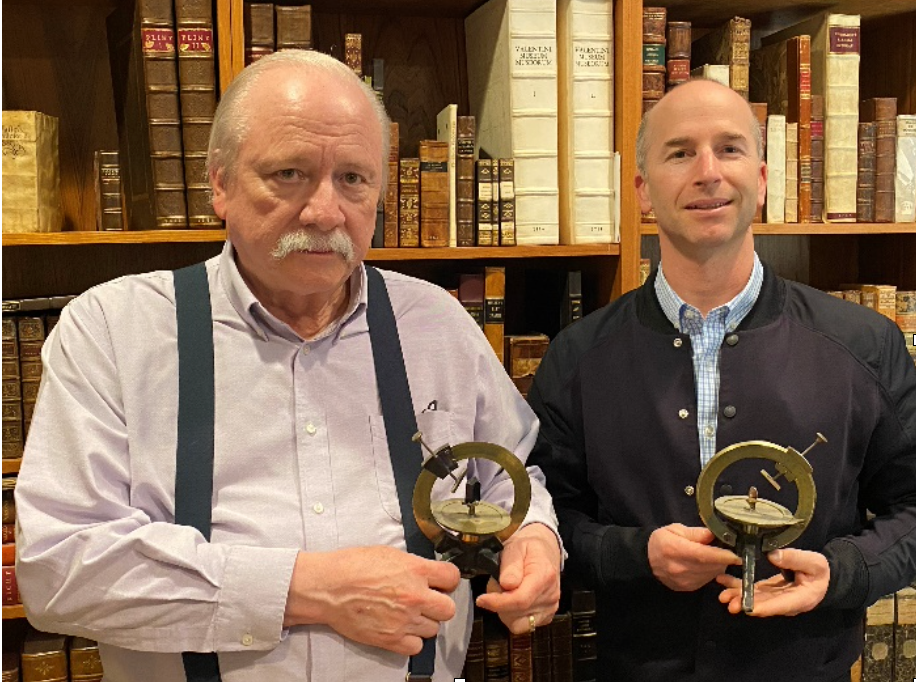
Foreword
Green Mountain Minerals is very grateful for permission to reprint Wendell Wilson’s essay “Connoisseurship in Minerals: Science, Beauty & History."
In this wide-reaching piece of scholarship, he begins in the Introduction by defining for us the criteria by which a connoisseur of minerals may be distinguished, and those aspects of understanding that must be developed to become a true connoisseur.
The next three sections discuss those criteria in some detail, beginning with an appreciation of the Scientific aspects of minerals and the important Criteria thereof. He then defines what he means when he talks of the Aesthetic Appreciation of minerals, and then, in arguably the most important section of the essay, the Aesthetic Criteria one should apply to recognize a truly great mineral specimen. In the final segment of this first part of the essay he explains why an understanding of the importance of Historical context, or provenance, of minerals is important.
The final segment of the work covers other aspects that may be considered by a connoisseur when evaluating a mineral specimen. These include both objective and subjective criteria. The former include Size, Rarity, “Enhancement”, and Cost. The more subjective criteria discussed are “Species Caste” (wherein some families of minerals are held in higher regard than others), and “Personal Factors” (such as emotional attachment).
The final paragraphs cover the skills that a connoisseur should possess: the ability to Recognize Fakes, to Financially Appraise a mineral or collection, and to have some degree of Specialization or Provincialism.
We have illustrated Wendell’s words with a selection of minerals that have been owned by Green Mountain Minerals, and that now reside in many of the world’s great collections.
Introduction
The word connoisseur is derived from a word in Old French meaning “a judge, one well versed,” which in turn comes from the Latin word for “one who knows.” Today we define a connoisseur as “a person who has expert knowledge and keen discrimination in some field,” and as “a person who is especially competent to pass critical judgments in matters of taste.”
Connoisseurship in minerals is a complex and challenging subject, based on knowledge, discrimination, enthusiasm and aesthetics. Because the principle attribute of a connoisseur is that he (or she) be qualified to judge, it is not absolutely necessary that he own specimens. More fundamental are his knowledge of minerals, his appreciation for history, his development of standards or criteria for specimen evaluation, and his ability to apply those standards accurately and intelligently. In actual practice, however, it is usually essential that the connoisseur have a background as a mineral collector, even though he may no longer possess a collection.
The three cornerstones of mineral connoisseurship are science, aesthetics, and history. Scientific and historical knowledge of mineralogy, mineral specimens and mineral localities may be gained from books, from historical documentation, from formal study and from personal experience. The development of an aesthetic sense is not so simple. Paul Desautels (1920-1991), former Smithsonian curator and one of the leading mineral connoisseurs of the 20th century, wrote in 1988 that “The greatest mineral collectors of all time have collected both scientifically and aesthetically.” And also, he might have added, with an eye to provenance. It is necessary to understand these three components separately, along with several other factors, before combining them into a coherent concept of connoisseurship.
There will, however, be no attempt made here to define who is and who is not a connoisseur. No one can achieve total knowledge and perfect sensitivity with regard to minerals, so true completion of the goal is out of everyone’s reach. It is more a matter of achieving some degree of connoisseurship, and perhaps eventually a high degree, but there is no clear dividing line in this continuum.
Aesthetic, scientific and historical appreciation of minerals can be thought of as dealing primarily with the visible and the invisible, respectively. Purely aesthetic appreciation requires no mineralogical knowledge whatsoever; it deals only with what we see. But once we lapse into an appreciation of unseen aspects which a specimen represents or reflects, we are necessarily involved in an experience requiring some scientific and historical knowledge.
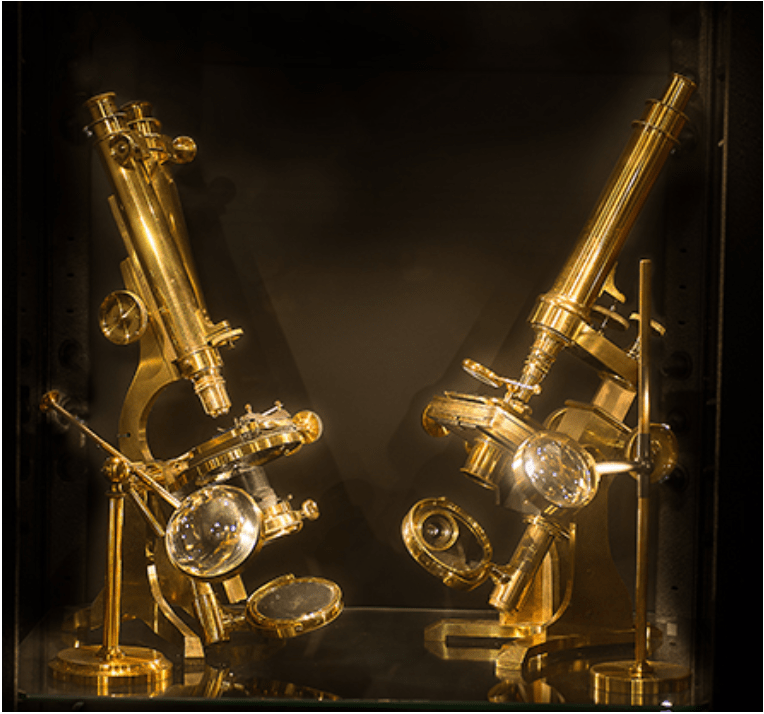
The petrographic microscope, illustrated here in its finest Victorian incarnation, has been one of the basic tools for the scientific enjoyment & identification of the complexities of the mineral world.
Scientific Appreciation
The mineralogist, trained in the concepts of crystallography and chemistry, sees in minerals a complex system of atomic relationships which is a direct consequence or expression of the laws of chemistry and physics. That such a wide range of orderly structures and compositions can form naturally seems to testify in favor of an orderly universe, and a scientist virtually by definition finds that order beautiful. Each new discovery, each solution of a unique crystal structure, each revelation of a new relationship, each identification of a new species, yields satisfaction in seeing a new piece fit into the immense jigsaw puzzle of nature. Everything relates to everything else at one level or another. These are intellectual concepts; therefore, much foreknowledge is necessary to appreciate the way a particular mineral fits into the pattern.
Scientific appreciation of minerals is thus based on a drive to gain knowledge of the unseen nature of minerals. For some mineralogists and mineral collectors this quest is enough, and yields ample joy for a full life. They feel no need to invest time, energy and money in the study of aesthetics or history, preferring instead to devote all of their personal resources to the enjoyment of the scientific experience.
Scientific Criteria
There are two fundamental criteria for any scientific appreciation of mineral collecting. The first criterion is size (that the specimens themselves are large enough to be visible or can be made visible with available magnification), and the second criterion is accurate identification. Some collectors can subsist solely on this much, acquiring sand-grain-size or smaller specimens properly identified by someone else as to species. The enjoyment comes virtually entirely from what they know intellectually about the purported species rather than what they can visually evaluate in the actual specimen.
These, however, are not the only criteria. A third criterion, and one insisted upon by connoisseurs, is that the specimen show enough of its potential characteristics to be sight-identifiable. It is impossible to base a connoisseurship of something entirely on data or analyses which are dependent on the skill or equipment of others, because one’s own skill and knowledge are then not required. Connoisseurship must rely on one’s personal skill or it has no meaning.
To sight-identify a specimen as to species is to pick up visual clues to its unseen aspects. The clue may be, for example, a re-entrant angle indicative of twinning, a color or zonation indicating chemical or structural peculiarities, a crystal form giving evidence of unusual internal symmetry, surface growth features suggesting a certain chemical environment, and so on. These clues are what trigger the scientific appreciation of mineral specimens. The more frequent and better developed they are, the more affecting they become. In this sense only can relative judgments be imposed on specimens from the scientific viewpoint, and to make such judgments a connoisseur must possess significant scientific knowledge.
Of all these scientific criteria, the presence of a recognizable (euhedral or subhedral) crystal shape is generally held to be the most important. The crystal forms are a manifestation of the internal structure which, together with chemical composition, defines the mineral’s identity.
A fourth criterion is the demonstration of relationships. Epitaxy, associated species, intergrowth textures, matrix material and so on provide clues to the many ways in which one mineral can be chemically, crystallographically or temporally related to another. Clues to relationships involved in a mineral’s origin are especially valued. Here again, the visual clue by itself cannot yield scientific appreciation in the untrained mind; knowledge of mineralogical science is essential.
A fifth criterion (really an extension of the third and fourth) is the visible aspect which presents a scientific mystery. It might be argued that a lack of data to explain a phenomenon cannot be scientifically appealing, and this is a strong point. But the mystery which presents itself is really the door to understanding, and is highly valued in science. Such mysteries do present data—but data which we cannot as yet fully interpret. (Consider, for example, the unexplained causes of mineral rings and cylinders, or the “bulging” faces of diamond crystals, or the twisted gwindel crystals of quartz.) A visible mystery is not really an informational void but rather a tantalizing and engaging clue to new knowledge.
These individual criteria for the scientific appreciation of minerals are usually not recognized consciously by collectors. Simplifying the concepts down to a single word, people describe a specimen having scientific appeal is “interesting.” That is, it engages the intellect.
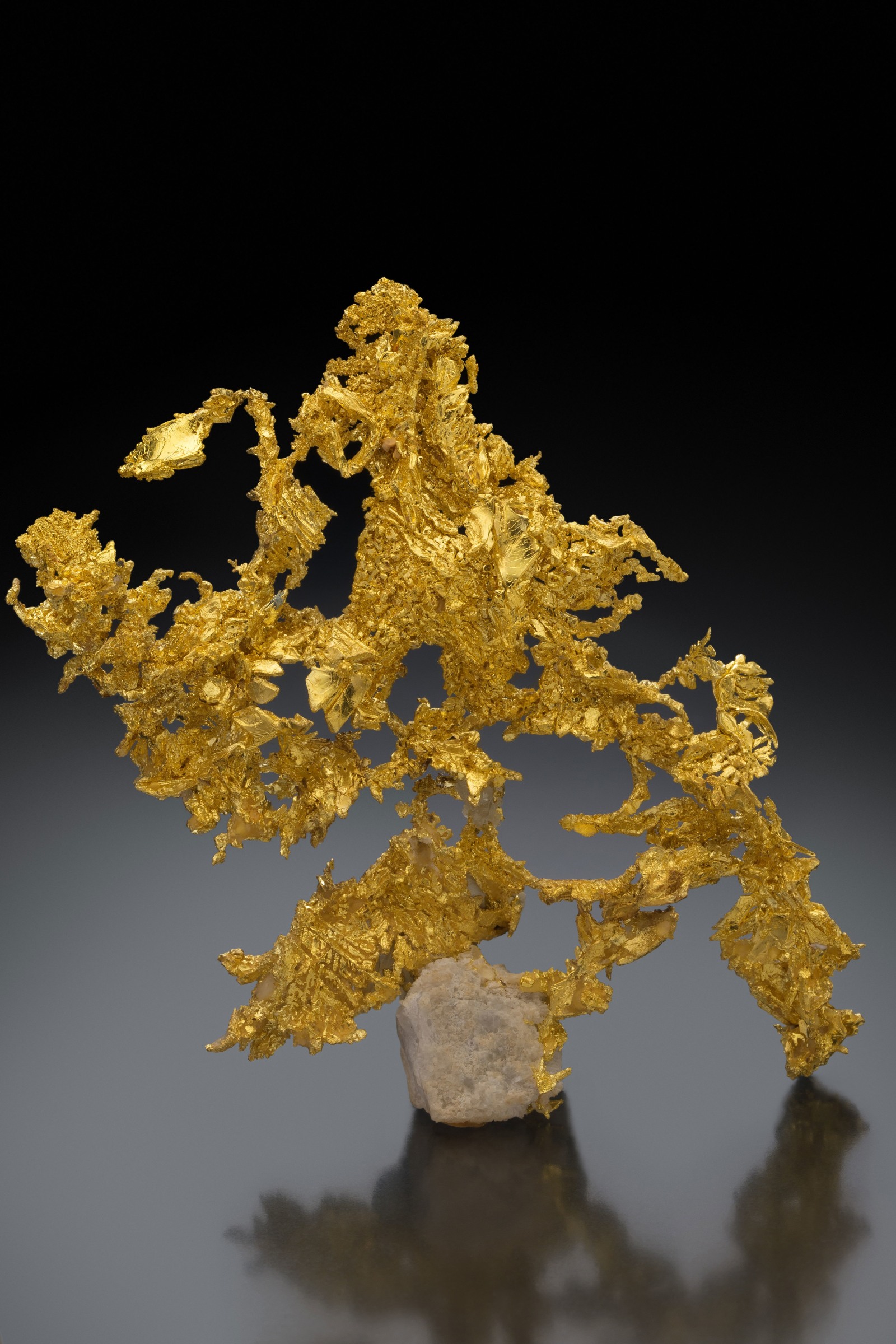
Gold, Eagle’s Nest Mine, Placer County, California, USA
Of all the world’s minerals, it is unlikely that any have quickened the pulse of humanity, or excited their sense of beauty, more than native gold. This specimen of crystalline gold from the iconic Eagle’s Nest Mine in California stands out not only for its astonishing degree of crystallization but for the aesthetic shape that nature wrought as it crystallized.
Aesthetic Appreciation
Aesthetics is a different matter, and a more essentially subjective one. The word cannot be defined without reference to man. The relative judgments we make in pronouncing one mineral specimen more aesthetic than a hundred others of the same species are purely a reflection of our own individual minds. Thus, defining or explaining mineral aesthetics is to some extent an empirical problem: if enough people pronounce something beautiful, then it is beautiful. If a certain standard is widely applied by many people in making aesthetic judgments, there can be no arguing with its statistical validity. Nevertheless, no person’s judgment can be proclaimed wrong, even if he is the only person on the planet holding that view. A person’s judgment on aesthetics can only be called wrong in a statistical sense, that is, if he inaccurately claims that a certain proportion of other people would agree with him.
In this discussion the goal must therefore be essentially statistical: to identify and explain the criteria that most people use in judging mineral aesthetics. Unfortunately, however, statistics cannot be the sole element in evaluating aesthetics. Two other factors must be incorporated: experience and fashion.
If experience were not a factor in judging aesthetics, each of us would be born with perfect taste, and there could be no such thing as a refined sense of aesthetics. To develop taste, a person needs a large mental databank and a collateral learned sensitivity to subtle variations. Without these he cannot intelligently define and apply his own aesthetic criteria, whatever they may be. Certainly it is all a matter of degree, and everyone has at least some experience in viewing solid material objects and sensing differences. At worst, a normal person can only have “poorly developed” or “unusual” taste. Naturally, for the purposes of this discussion, we will weight the statistical analysis in favor of those persons having maximum experience and learned sensitivity. There is nothing objectionably discriminatory in this approach; it merely allows us to see the human mind in sharper focus.
The second mitigating factor, fashion, is a somewhat ephemeral variable in that it changes with the times and it can be dictated by the elite. In truth, no one can dictate taste…they can only dictate fashion. A person may ignore his own taste and cave in to fashion; he may devalue his own judgment in his own mind so that he adopts someone else’s stated preferences. But his taste is individual and can be refined only through direct experience; fashion is social and can be swayed by social pressures having nothing to do with aesthetics. Being social animals, we can never be entirely sure we have separated the transitory social components from our aesthetic judgments.
In this discussion we will strive to distinguish those eternal aesthetic verities (presumed to exist) that allow taste to rise above temporary fashion. But we can never be sure of totally achieving that ideal. Any confirmation will require the perspective of centuries on the part of writers and thinkers looking back from the far future. It’s important to remember that questions of aesthetics have been debated by the finest minds for more than 2,000 years, so we’re probably not going to settle them once and for all in our lifetime.
By whatever means it is that we each arrive at our own criteria for judging aesthetics, it is the satisfying of these criteria that yields us beauty and joy. For some mineral collectors this is enjoyment enough; they feel no need to invest time, energy and money in the acquisition of scientific competence and understanding or historical background information. They prefer instead to devote all of their personal resources to the enjoyment of aesthetics.
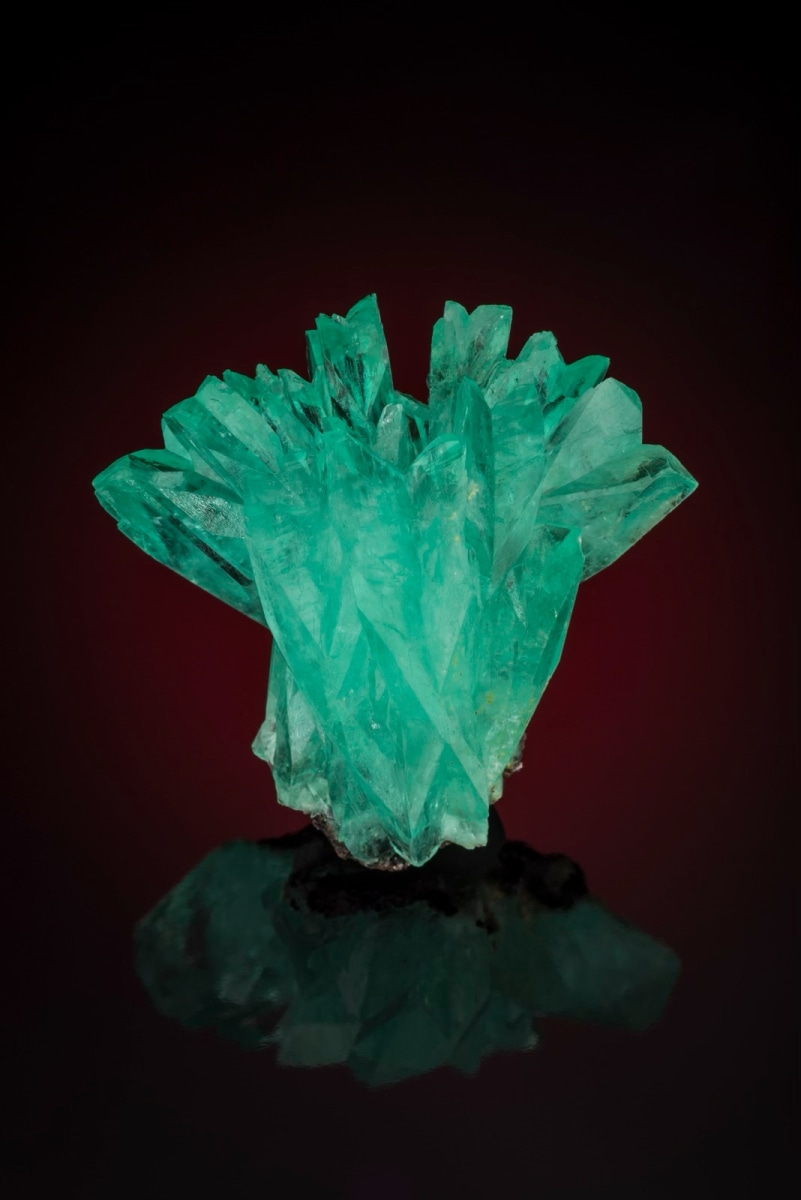
Phosphophyllite
Unificada Mine, Cerro de Potosí, Potosí City, Potosí Department, Bolivia
Aesthetic Criteria
To say that a specimen is beautiful begs the question: why is it beautiful, in the absence of all technical knowledge about it?
Perhaps the most significant characteristics that some minerals can possess, which are universally thought of as beautiful, are clean color (lacking overriding gray, brown or milky tones) and transparency. For some obscure reason, people derive pleasure from gazing into a colorful, transparent solid…it seems to be a fundamental peculiarity of the human mind, producing an almost tranquilizing effect. Many mineral species are incapable of exhibiting these characteristics, the opaque metallic minerals for instance, but for any species that can show bright color and transparency, the connoisseur will expect it to do so in the finest specimens.
Transparency gives evidence of internal perfection, as if the crystal interior had been swept clean of litter and dirt. It also requires a lack of internal damage (cracks), and a lack of growth flaws and inclusions. These are characteristics which people value in all areas of life, not just in minerals, so we can feel relatively certain that the criterion of transparency is a fundamental one and not a passing fashion. The ultimate transparent specimens are referred to as “waterclear” (a word having equivalents in several languages, e.g. wasserklar in German), so perhaps the basic human need for pure drinking water is a factor underlying our instinctively high valuation of perfect transparency.
Clean, bright color as a standard of beauty is difficult to trace to its origins. Perhaps it stems from our ancestral primate recognition of ripeness in fruit being associated with bright color. Even bees use this color cue as a guide to food, in flowers. Then again, experience shows us that as things age and deteriorate they again lose the brightness of their colors. This is especially true of food, but also of ourselves and of most other living things: “From (relatively colorless) dust we are born, and to (relatively colorless) dust we (and all life on the planet) shall return.” “Fresh” color is quite literally a sign of vitality, and the ability to recognize it and be attracted to it is a fundamental survival characteristic common not only to humans but to many other animals as well. So, once again, we can feel relatively confident that clean, fresh, strong color is an enduring standard of beauty. It should be remembered that, in purely aesthetic terms, the actual origin of the color in a mineral is immaterial; origin is one of those unseen aspects which the trained mineralogist understands intellectually but cannot determine visually, and as such it falls within the province of scientific appreciation.
Another fundamental aesthetic aspect is sculptural shape. A broken or stream-rounded lump of mineral can possess color and transparency, but has no coherent external design. Why do we prefer things to have recognizable, rational, relatively consistent shapes? Probably as an aid to recognition; we learn as infants to begin recognizing things by their shapes, perhaps even before we can recognize colors. This, however, is an intellectual reason for appreciating coherent design. The mere possession of crystal faces is not an aesthetic criterion. To impress us aesthetically, the overall shape of crystals, crystal groups and matrix, individually and in concert, must take on a pleasing “sculptural” quality. Most often the sculpturally pleasing shape is best viewed and appreciated from only one direction, designated the “front” of the specimen. The ultimate in sculptural quality, however, is the specimen that is appealing from all sides—360-degree viewability. The term that has been applied to this very rare quality is “sculptural integrity.”
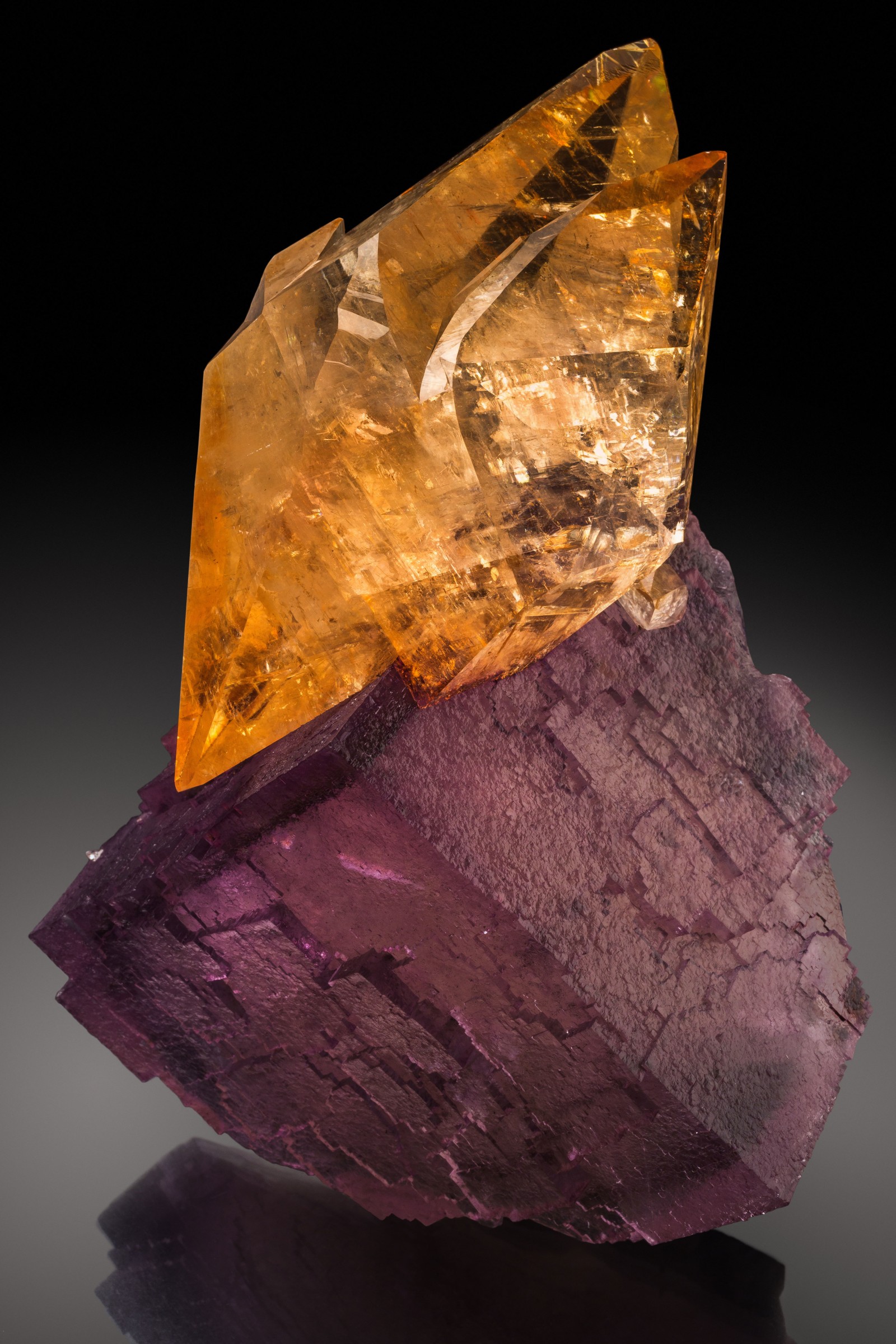
Calcite on Fluorite, Elmwood Mine, Smith County, Tennessee, USA
If color, transparency and sculptural shape are the three principal criteria by which we define the aesthetics of a mineral specimen, then this calcite and fluorite combination from the Elmwood mine must surely be one of the most aesthetic minerals ever to have been recovered from the earth! The piece also manages to combine a beautiful combination of surface textures, with the glassy luster of the calcite contrasting with the sculptural texture of the fluorite
We will probably never understand fully what makes one sculptural shape slightly more aesthetically pleasing than another. Personally I suspect that it has to do with subconscious mathematics. A part of our mind is constantly engaged in making visual proportional estimates and comparisons on several levels. (Benoit Mandelbrot, known for his work in fractal mathematics, said that beauty exists when there is detail at all levels.) When numbers or ratios are found to repeat, resonate or harmonize in novel ways, a sort of pleasure alarm goes off in our minds. Music appreciation may be based upon the same concept. This may, to some extent, be an aesthetic counterpart to the scientist’s intellectual pleasure in a universe that is logically consistent and interrelated. A reverence for order and symmetry, whether expressed aesthetically or intellectually, may well be inborn in us, as suggested by extensive cross-cultural studies showing general aesthetic preference for rectangles having a ratio of side lengths equalling 1:1.618 (the so-called “golden section”).
In any case, the detailed, conscious and subconscious computations involved in recognizing aesthetic shapes must be developed, refined and expanded over a lifetime. Only through long experience can a person become a connoisseur with respect to aesthetic shapes and compositions. The intensive study of art aids in this developmental process as much as does the study of fine mineral specimens themselves. The subconscious computational center of the mind must be exercised over and over, preferably in the analysis of already recognized artistic masterpieces and great mineral specimens in museums (overlooking, of course, the many inferior specimens in museums!). In this way the great connoisseurs of the past, who have identified these masterworks for us, can help save us time in learning aesthetic compositional analysis. It is not something that can be explained in words, beyond telling us that this one is bad, this one good, and that one great in its composition. Given that much to go on, our subconscious minds must then work out the hidden mathematics. This is beyond the abilities of some people, but it is an essential aspect of connoisseurship.
A quality related to shape might be referred to as crystal development. The overall sculptural quality of a crystal cluster may be aesthetically pleasing, but if the individual crystals are not well developed the quality will suffer. The individual crystals should have the well-formed proportions and a selection of crystal forms which represent that particular species in its highest level of development. They should be arranged in such a way that they do not overly impinge upon and compromise each other. And their arrangement and range of crystal sizes should provide some kind of focal point, usually the largest and best crystal located in a prominent and aesthetically comfortable position.
Although the presence of matrix upon which the crystals grew is of scientific value (representing the local geology, the environment of crystallization and usually some associated species), matrix is also of critical aesthetic value. It provides a structural base to support the crystals and crystal clusters, adds textural variety and may also provide a site for attractive subsidiary associated species. For these reasons a specimen always appears more aesthetically complete if matrix is present. The matrix must also be in a comfortably aesthetic size relative to the size of the crystals, and this can sometimes legitimately be adjusted by some judicious and skilful trimming. And the crystals should stand up boldly on the matrix—a quality which Jack Halpern (2005) refers to as “crystal relief.”
Associated species have scientific value (representing more fully the physiochemical environment at the time of crystallization) and can also add significantly to the aesthetics of a specimen by providing contrasting colors, shapes and crystal sizes that harmonize attractively with the main species. If two specimens are being evaluated, both with more or less identical crystals of the main species, but one with interesting and attractive associated species, the connoisseur will choose the latter every time.
Yet another aspect is surface quality. We have discussed the importance of shape, but the quality or nature of the surface is a separate characteristic. Luster is a general term describing the overall reflective effect resulting from the fine-scale shape of a surface and the refractive and absorption indexes of the species.1 With minerals we are generally speaking of crystal surfaces which, if perfect, are absolutely flat all the way down to the atomic level. In nature there is no such thing as literal perfection, but the approach can be quite close. Imperfections, or deviations from flatness, can come about in a variety of ways, from crystal growth defects to growth around surface contaminants and reverse growth or dissolution as a result of corrosive liquids or gases. All irregularities reduce the amount of light that is reflected in a single direction from a face, reducing the brilliance of the reflection. The ultimate is generally referred to as “brilliant” luster or “mirror-smooth” faces.
It should be remembered that, in the case of transparent crystals, light can be reflected from the interior side of the face as well as from the exterior side, thus increasing the total amount of light being reflected back to the viewer. With colored minerals (as with faceted gemstones) internal reflections can deepen the apparent color. This is because a beam of light passing through a crystal, being reflected off an interior face, and then passing back out through the crystal again has a longer path than a beam passing straight through; the effect is the same as if the crystal were thicker. Attractive color effects based on the vector-dependency of pleochroism can also arise. Thus a high luster can contribute toward the criterion of intense color.
It is difficult to say why a brilliantly reflective surface is universally considered beautiful. Through experience we learn that such surfaces are more nearly perfect, simply because they can be degraded so easily by scratches and other damage. Here we approach once more a fundamental peculiarity of the human mind: the search for perfection. Perhaps this too is fundamentally mathematical. Perfection requires the simplest mathematics to fully describe, and produces unique resonance in the analytical mind. To study a perfect crystal face, searching for the inevitable defects through a whole range of scales and finding none, can produce a momentarily vertiginous feeling, like looking down a well. The effect can be almost unsettling, because we know that the nearer the approach to perfection, the greater the fragility, rarity and preciousness. In any case, we can be sure that the criterion of perfection, in a wide range of different aspects, is an eternal one.
Some crystal faces are actually composed of alternative or distorted crystal faces of several different orientations. There is a continuous range in terms of scale and size, but at some point the irregularities pass from being evaluated as luster to being judged for shape. A lack of surficial perfection may conceivably pass into a superior variation in overall shape, one criterion merging with or transforming insensibly into another. The connoisseur’s skill in applying his criteria and making finely discriminating judgments is essential.
An object may be born with inherent imperfections, or it may be born relatively perfect and then suffer tragic damage. The sense of loss felt in the latter case is so aesthetically disturbing that freedom from damage becomes a criterion of its own. Seeking freedom from damage is, in a way, the more practical approach to finding perfection because with the abundance of damage in the world it is far easier to dismiss damaged items en masse, and see if anything remains. In rare instances, however, certain kinds of damage can contribute to an improvement relative to other criteria (internal reflectivity and color intensity, for example). Similarly, with regard to luster, a crystal with alternating lustrous and frosty faces may be deemed aesthetic for that reason. In such cases the criteria must be balanced against each other in making a judgment, and a connoisseur’s fine sensibilities are once again essential.
A discussion of damage soon brings to mind the question of durability, a quality which Jack Halpern (2005) regards particularly highly inasmuch as he lives in an active earthquake zone (San Francisco). Even if earthquakes are not a hazard, though, specimens which are overly fragile are certainly at a disadvantage in the connoisseur’s mind. If a specimen cannot be handled and studied without inflicting some damage, the enjoyment it provides is seriously compromised.
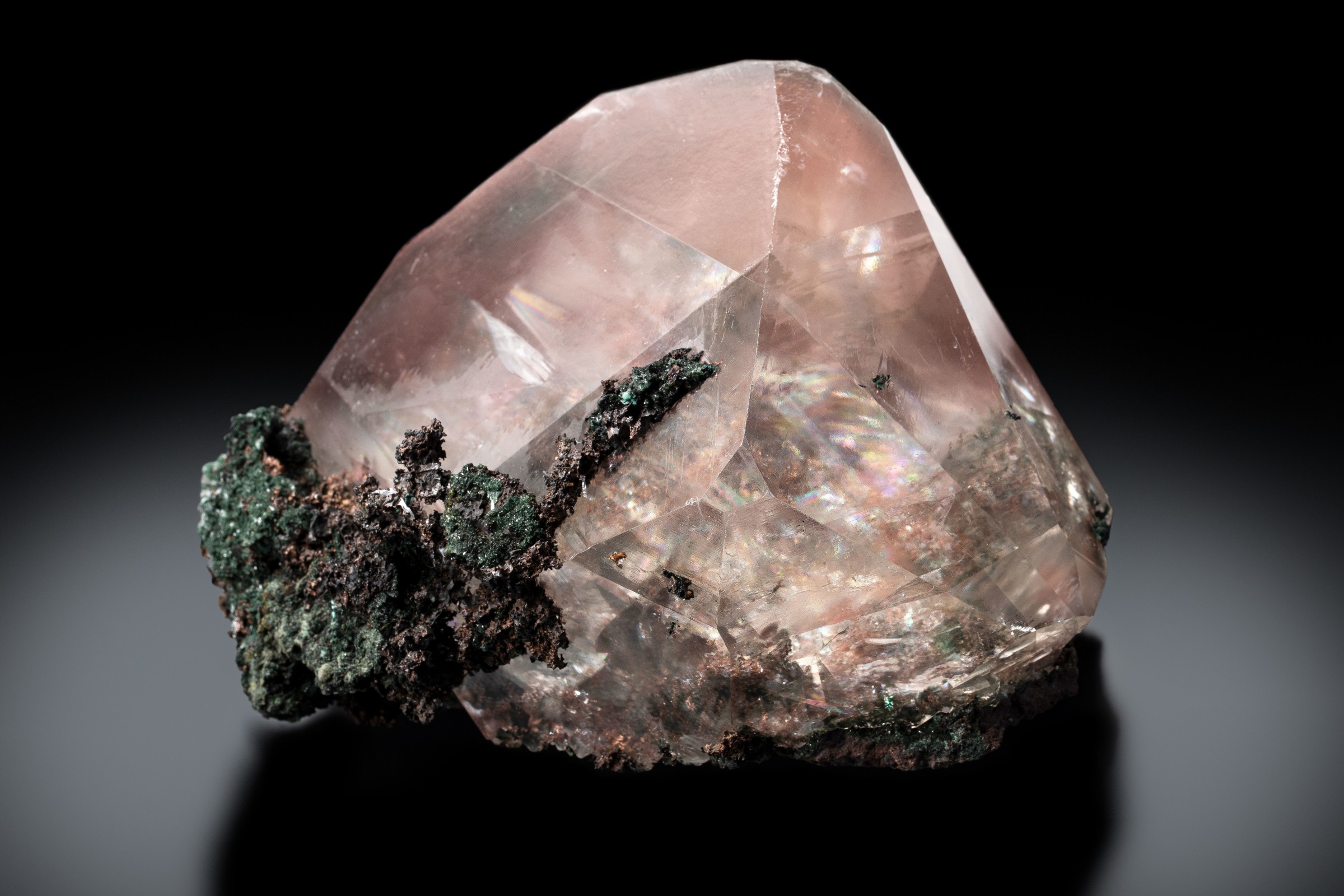
Copper-included Calcite, Tamarack Mine, Houghton County, Keweenaw Peninsula, Michigan, USA
The copper-included calcites of Upper Peninsula Michigan are reminiscences of an important era in the industrial development of the United States. This one has exceptional provenance documentation, tying it back through several iconic US collections to the owner of the Tamarack Mine at the time it was recovered.
Historical Appreciation
A specimen’s provenance – the locality where the specimen was found and the history of that specimen since the time it was collected – is always of interest to the connoisseur. Being, like the scientifically appreciated aspects, an unseen factor, provenance requires both a confidence in the data and a significant historical database for comparison.
Generally speaking, the more a person knows about the history of mineralogy and the history of mineral collecting, the more he will appreciate historical provenance. In an exact parallel to scientific appreciation, the provenance data accompanying a specimen can be correlated with its place in human history to yield insights and intellectual satisfaction. To know that a specimen was, for example, once a part of the collection of the pioneering crystallographer René Just Haüy is as enjoyable to contemplate historically as knowing scientifically that the species is the sole representative of its crystal class. But one must know who René Just Haüy was, just as one must understand the derivation of the crystal classes. Consequently, a connoisseur must know some history, as well as science and art.
In order to appreciate provenance the connoisseur must also be shrewd in his ability to critically evaluate a specimen’s purported history. Simply taking someone else’s word for it requires no discriminatory powers. Has the specimen passed exclusively through the hands of reliable and unbiased people? Can it be correlated with published descriptions or illustrations? Does it have an original label that appears authentic, and does the label carry a catalog number that is painted on the specimen? Can the handwriting on the label be recognized? Is the original catalog still extant and can an entry therein be matched with the specimen? Are letters or other supporting documentation available? Many questions must be answered before important provenance is accepted. And many specimens have irretrievably lost their provenance. Although scientific aspects (including the exact locality) may often be rediscovered through new analyses, historical provenance, once lost, is likely never to be regained. Consequently the connoisseur does all he can to verify and preserve labels and other provenance documentation.
Of special consideration in the area of provenance is the renown of the locality. Specimens from famous mineral localities are often considered more desirable and valuable for several reasons. They are more evocative of a well-known mining history and perhaps colorful cultural background than specimens from new or obscure localities. And they may fit readily into pre-existing suites of specimens. Furthermore, they may already have a built-in population of admirers in those people who have previously been specializing in that particular famous locality and are experts in its mineralogy. Being more publicized, the locality attracts a bigger bank of potential buyers who would want such a specimen, thereby driving up the price somewhat. Minor variations may be held in higher esteem by such collectors.
Other Factors

Tourmaline, variety Rubellite, “The Tarugo”, Jonas Mine, Itatiaia, Minas Gerais, Brazil
At 85cm in length, and with a weight of 82 kilos, the “Tarugo” tourmaline was the largest unrepaired gem crystal ever recovered from the Jonas mine, and is probably the largest ever recovered anywhere in the world. It can be seen today in the gem and mineral hall of the American Museum of Natural History in New York.
Size
Size is a surprisingly difficult aspect to evaluate in terms of fundamental appeal. All other things being equal, bigger is probably better. Unfortunately, all other things never are equal. With increasing size comes an increasing tendency towards defects of all kinds. Micromounters know well that the very best and most beautiful crystals of a great many species are under one or two millimeters in size. When size is balanced against the associated disadvantages relative other criteria, people fail to agree on an optimum. Thus there are micromounters, thumbnail collectors, miniature collectors, cabinet specimen collectors, and collectors who avoid size entirely as a criterion.2 Size should probably not be considered an aesthetic factor. Bigger may be better or more desirable, but beauty, in my opinion, exists independently of size. Size is more of a convenience factor related to ease of storage and display. However, larger sizes (quality being equal) can also be rarer, and rarity is definitely an enhancing quality (see below).
In practice, the well-rounded connoisseur is able to appreciate and evaluate specimens of any measurement, applying all of his other criteria in the context of size.
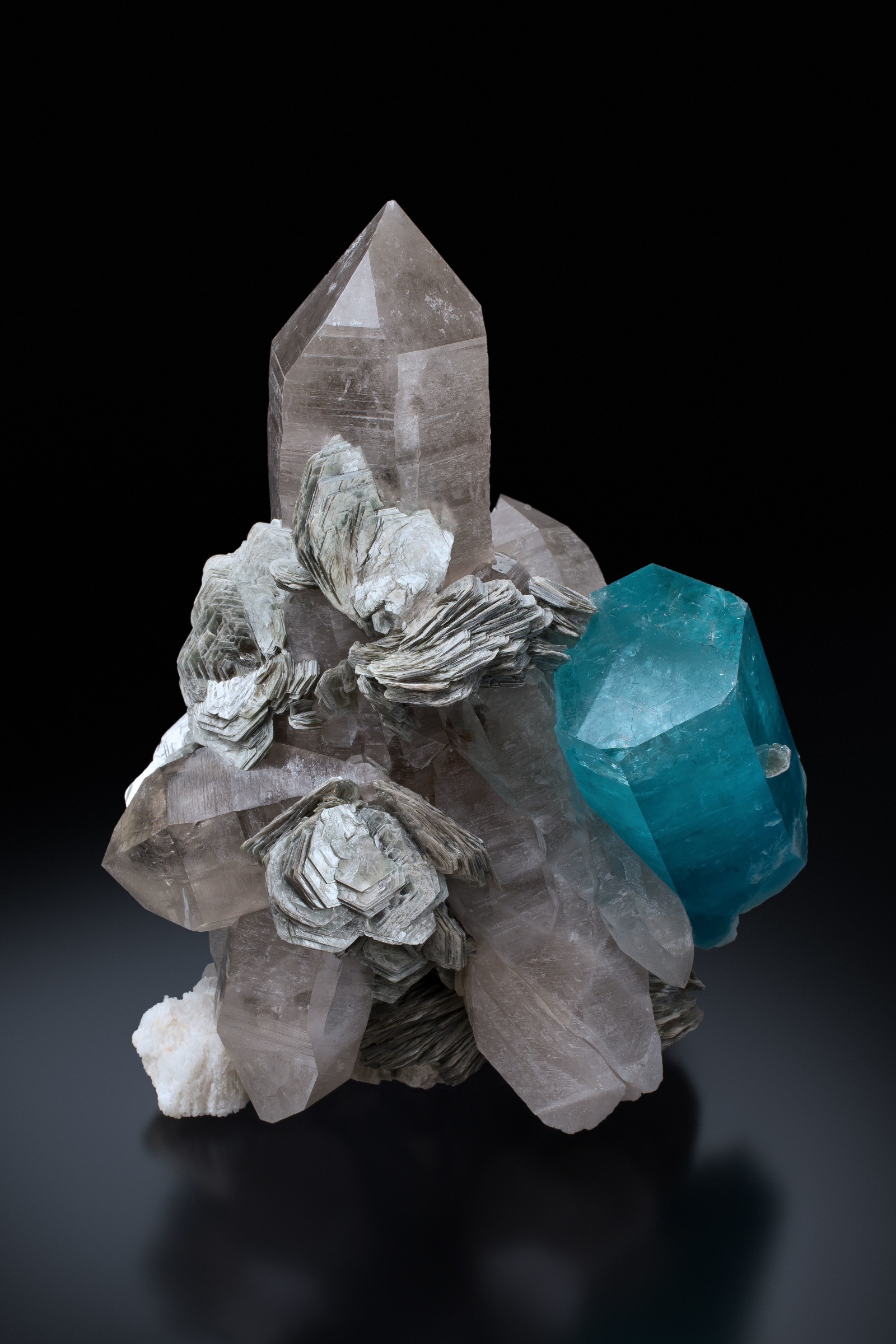
Aquamarine on Quartz with Muscovite, “The King of Nepal”, Taplejung District, Mechi Zone, Nepal
Although combination specimens of aquamarine with quartz and muscovite are not at all uncommon from the Western Himalayas in Pakistan, this extraordinary specimen is one of only very few to have been recovered from the eastern end of the Himalayan chain in Nepal, so it’s rarity is a function of locality, not mineralogy.
Rarity
Rarity is not an aesthetic factor or attribute, although in many minds it certainly contributes to a specimen’s desirability. Why do we like things that are rare? Perhaps it comes from our innate curiosity, expressing itself as a deeply felt gratitude to Nature or fate that we are allowed to explore data of very low general availability. But collectors tend to be competitive; so perhaps much of the attraction is a selfish or elitist pleasure in owning something which most other collectors cannot own.
Nevertheless, rarity is a (perhaps only temporary) circumstance, an outside factor, and maybe even an accident. Rarity of an individual specimen can change drastically without the specimen itself changing physically in any way.
Of course, certain chemical elements may have greater rarity, and thus to some extent the species which contain those elements may be considered rare, but there are many extremely rare species composed of very common elements. Germanium, for example, is considered rare, as are the minerals which contain it, but those minerals have been recovered by the ton at Tsumeb, Namibia. Contrast this with minerals like bideauxite, Pb2AgCl3(F,OH)2, or taaffeite, Mg3Al8BeO16, containing much more common elements but known in total quantities of only a few grams. Cosmic elemental abundance is therefore an unreliable standard for appreciating the rarity of minerals.
That rarity can be temporary is also well known. New discoveries are being made constantly, and in every case where earlier specimens are known, those specimens suffer a change in their rarity.
Rarity can be evaluated from many different viewpoints, including (1) rarity of the species, (2) rarity of the species from a certain locality, (3) rarity of the species having a certain crystal habit or color, (4) rarity of specimens having a certain provenance or history, (5) rarity of a species in crystallized specimens, and so on. Naturally the biggest, most richly colored, most lustrous, most transparent or most sculpturally pleasing specimens are virtually by definition rare, although proximity to the next specimens in rank makes a significant difference in how that rarity is weighed. In any case, owning a specimen that is among the best of its kind is a special pleasure.
The evaluation of rarity is in part simply a statistical exercise: “How many specimens have I seen like this or better?” The more massive one’s personal databank for comparison, the more significant the answer. But rarity is linked with size and with aesthetic, historical and scientific criteria in ways that make it difficult or impossible to isolate meaningfully. In terms of desirability, a specimen which is as ugly as dirt and carries no scientific interest benefits hardly at all from also being rare (or, for that matter, from being large or having an interesting provenance); but a very beautiful specimen benefits tremendously. Rarity, provenance and size tie the various scientific and aesthetic criteria together to form an interactive complex. They function as desirability enhancers, and their effect is more or less proportional to a specimen’s scientific/aesthetic desirability.
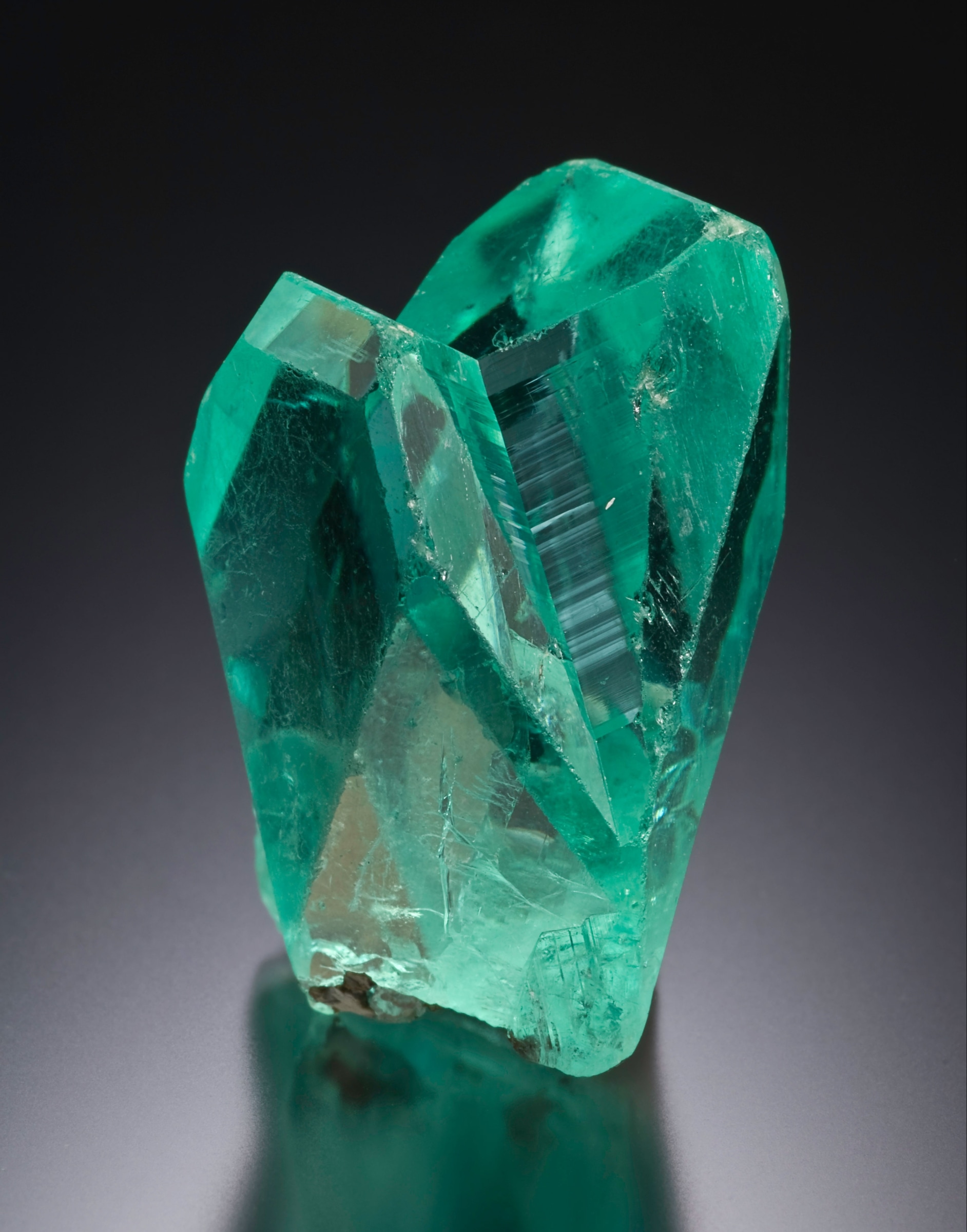
Phosphophyllite, Unificada Mine, Cerro de Potosi, Potosi City, Potosi, Bolivia
A classic mineral specimen of the First Caste!
Species Caste
Desirability is based on the degree to which specimens satisfy the various scientific, aesthetic and historical criteria, considered in view of their rarity. This kind of evaluation can be extended from individual specimens to species (especially species from certain localities). Wayne Thompson, in his book Ikons, Classics and Contemporary Masterpieces of Mineralogy (2007), described the concept of “species caste.” Desirability is often simply a function of species, the most desirable being those species that are known as specimens both beautiful and rare (such as phosphophyllite, blue euclase, cumengeite, proustite and scorodite).
The second caste consists of gem species and native precious metals, The third caste is species that are beautiful but not exactly rare (e.g. wulfenite, dioptase, azurite, rhodochrosite). The fourth caste consists of species that are beautiful but common (e.g. calcite, fluorite, galena, quartz).
The fifth caste includes species that are both rare and beautiful but never occur in large crystals (e.g. turquoise, variscite, annabergite). And the last two caste include species that are unattractive but rare, and unattractive and common. Understanding the species caste system is essential for the connoisseur, because it influences prices in major way.
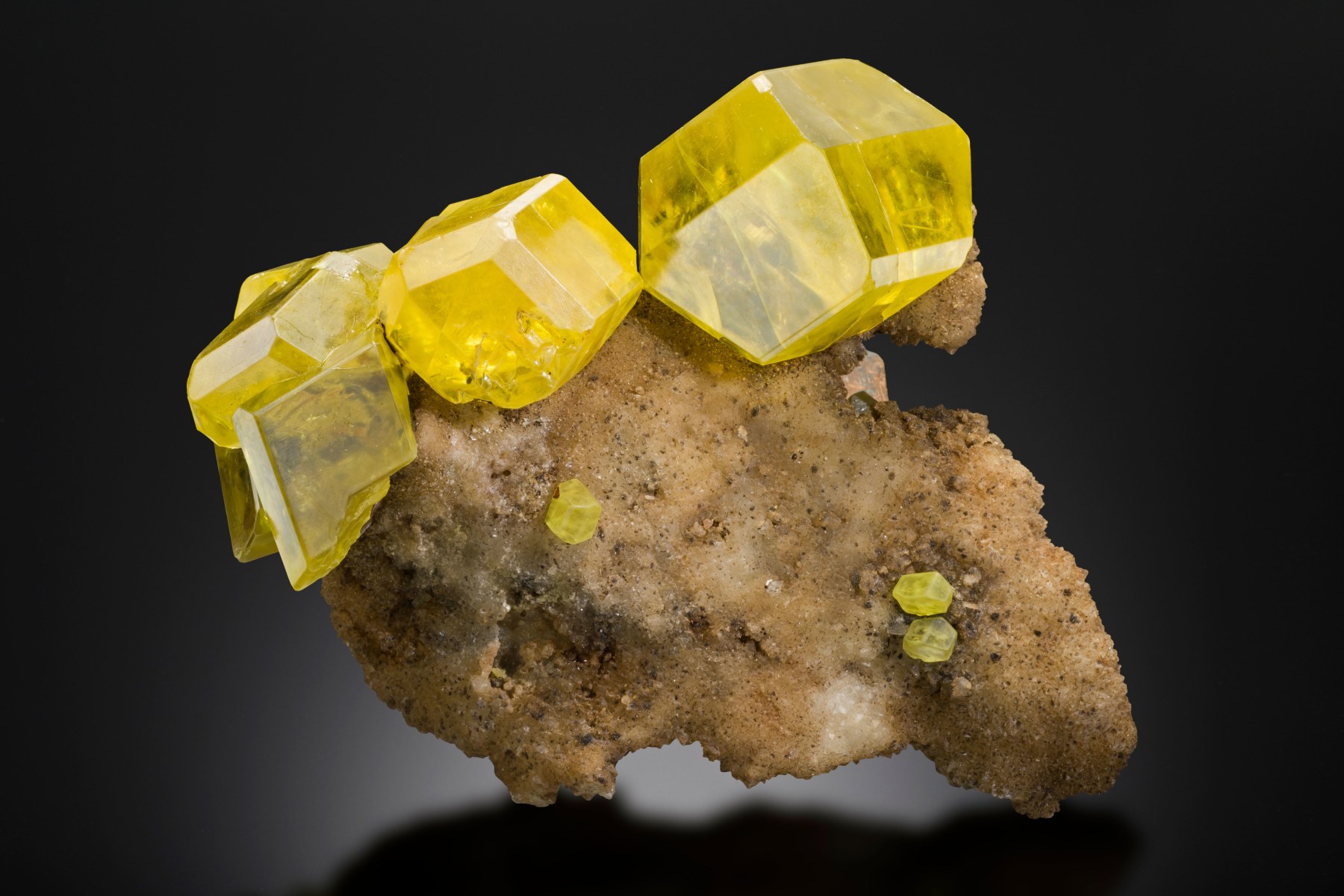
Sulphur on Aragonite with Bitumen, Sicily, Italy
This sulphur specimen is a beautiful example of its type, with excellent crystal form, translucency and lustre. Both the sulphur and aragonite are, however, quite common minerals, so are relegated in this view of the world to the fourth caste.
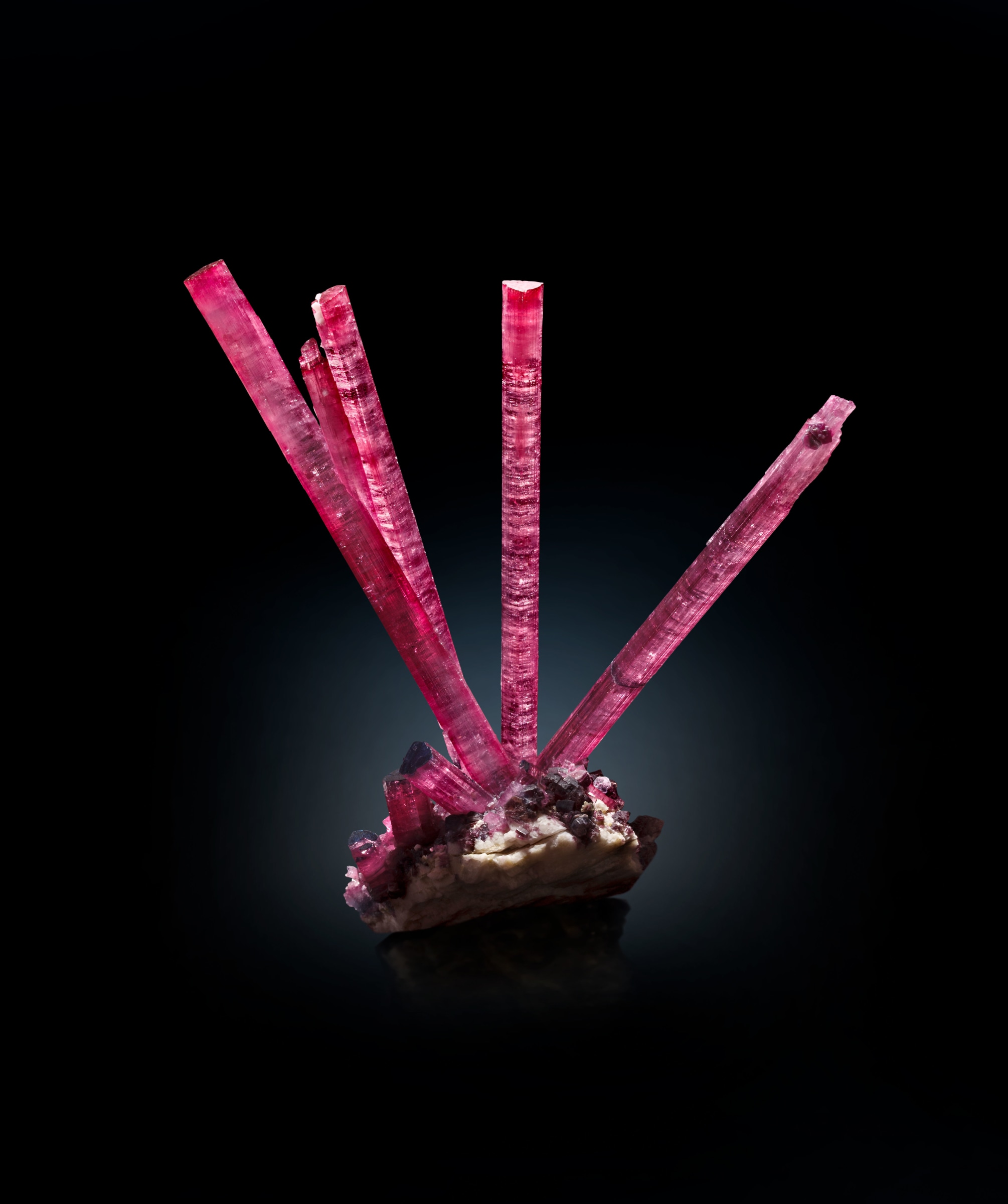
Tourmaline var. Rubellite “The Cranberry Crown”, Pederneira Mine, São José da Safira, Minas Gerais, Brazil
Tourmaline is one of the very few minerals for which restoration/repair/reconstruction is considered to be not only acceptable, but wholly appropriate. This is because the pegmatite cavities in which the minerals grew almost inevitably collapsed in the course of geological time, thereby naturally breaking these delicate, wand-like crystals. For pieces such as this, many hours of painstaking piecing together of a three-dimensional jigsaw results in an end-product looking just as Mother Nature intended.
Enhancement
Enhancement of specimens is a special field with its own experts and critics. Marc Wilson, curator of the Carnegie collection in Pittsburgh, divides enhancement into four categories (the “four R’s”): reinforcement, repair, restoration and reconstruction. All of these methods except reinforcement remain controversial and not all connoisseurs agree on what is acceptable. Where a repair is obvious, or where pieces are clearly missing, desirability must inevitably suffer. But where expert repairs are essentially invisible, many connoisseurs will feel no major decrease in their appreciation for the specimen. Replacement of missing parts with artificial substitutes (restoration) is much more controversial, and reconstruction is obviously of extreme concern.
Repair is the most common issue which must be dealt with. An invisible repair cannot affect aesthetics (which deals only with the visible), nor does it alter any of the existing scientific elements relating to the unseen aspects, parameters and concepts of mineralogy. The glue is a purely practical adjunct, its use comparable to mounting a specimen on a base for exhibit purposes. Less sophisticated collectors, lacking confidence in their own ability to discriminate between good repairs and bad ones, are inclined to shun all repaired specimens in order to protect themselves. Although understandable from a beginner’s viewpoint, this can quite literally develop into an irrational collecting phobia which is difficult to shake in later years. Most connoisseurs, on the other hand, are confident and capable of making the necessary fine distinctions; where their standards for repair are fully met, they feel no need to penalize the specimen.
Enhancement can also taken to fraudulent extremes (polishing faces to remove damage, adding false color, falsifying provenance, mismatching crystals and matrix, etc.—see Dunn, et al. 1981). See below.
Cost
Cost is obviously neither a scientific nor an aesthetic characteristic. And yet cost has a definite effect on the mind in determining how we view a specimen’s desirability. It is possibly an effect against which connoisseurs should learn to insulate themselves, but on the other hand it can be a distinct additional pleasure to view an emerald crystal and to know that it is worth five million dollars in cutting material! The philosopher George Santayana wrote on this point in his book The Sense of Beauty (1896):
There is no reason why cost should not heighten the tone of consciousness, and add to the pleasure with which we view an object. [A high cost] gives interest and poignancy to that which is present; our attention and wonder are engaged, and a new meaning and importance is added to such intrinsic beauty as the object may possess.
The connoisseur, of course, can judge a specimen’s dollar value for himself and need not rely on the statements (or asking price) of someone else in any particular case. This helps him avoid being unduly impressed by a high price tag. Some mineral dealers, for example, use the cost effect to their advantage: if a specimen has remained unsold for too long, they will double its price and see what happens. Often it will then sell promptly!
Personal Factors
There are personal factors in the appreciation of minerals which are specific to each collector, and he should be careful to factor these out of his judgments when necessary. For example, a specimen which was once given by a dear friend, or which calls to mind the collecting days of one’s youth, will have no such value for anyone else.
A problem involving personal factors often arises when a collector decides that the time has come to sell his collection. This is often an emotional time which marks a great turning point in his life. Because of personal factors, he will be strongly inclined to make two fundamental errors: (a) he may overprice the collection, and (b) he may wish to see it sold as a unit to someone who will keep it all together in his memory instead of breaking it up.
The source of the first error is usually the price originally paid for each specimen. Many collectors feel that they have a right to recoup their original “investment,” and some people also fully expect appreciation in value, as if interest were being earned on a bank account. Unfortunately, there is no validity to either of these expectations. Current market conditions and nothing else will determine the retail value of a specimen; original purchase price and date of purchase mean nothing. The market value of individual minerals may go up, down or remain static over time. To quote Santayana (1896) again, “Nothing so much enhances a good [object] as to make sacrifices for it”; but the sacrifices, in terms of money spent or effort expended in acquiring specimens, are the owner’s alone. Personal sacrifices are of little interest to anyone else. The connoisseur must be able to purge his mind of such personal factors if he is to accurately evaluate his own specimens.
The source of the second error is the similar belief that all the work, time and money expended in the assembly of the collection should have some enduring value to others. But this is no more true of collections as a whole than it is of individual specimens. Other people are involved in building their own memories and their own collections, and cannot feel the same way as another collector might about his own collection. It is actually quite rare that a mineral collection will deserve to be kept together as an inviolate unit, for historical, scientific or aesthetic purposes, or perhaps as a study collection for teaching purposes, after it passes from the hands of its builder. The connoisseur dispassionately recognizes those collections which would benefit others by being kept together, and those which should be broken up, even in the case of his own.
Recognition of Fakes
The recognition of fakes is a valuable skill for the connoisseur. Human nature being what it is, there is always the danger that some specimens will have been artificially modified so as to better meet the standards of the connoisseur. Luster, color, clarity and shape can all be altered to improve aesthetic appeal; even scientific aspects can be falsified (e.g. addition of foreign matrix or falsification of locality data)(see Bentley et al., 1986). A critical, suspicious and discerning eye is necessary for the connoisseur to avoid being fooled. It is of little use to have highly refined scientific and aesthetic criteria if those criteria can be easily circumvented or deceived by unscrupulous people. Protection requires knowledge and experience, so that very subtle deviations from the natural state can be recognized (see Dunn et al., 1981). The connoisseur must have a substantial knowledge base about specimen fakery in all of its myriad manifestations, so that he can recognize it when he sees it. This ability is one of the critical skills that sets the connoisseur apart from the average collector, not just in mineral collecting but in any field of collectibles. Whenever specimen values rise to the point where fakery becomes economically profitable, it will be attempted.
Financial Appraisal
One of the skills which people expect of a connoisseur is the ability to make an accurate appraisal of the dollar value of any mineral specimen. This can be extremely difficult because all factors come into play, including the transient ones such as fashion, and all specimens must be reduced to a common denominator. Furthermore, different dollar values may apply to a single specimen, depending, for example, on whether a quick replacement value (for insurance purposes) or a quick sale value (for forced liquidation) is wanted. It also matters which dealer will be doing the selling or buying. To know dollar values, one must know “the market”; that means knowing most of the people in it, and using these contacts to track the prices that good specimens are bringing at any given time. A “system” for valuation (such as that proposed by George L. English in 1927), no matter how carefully constructed, will always be inferior to experience and empirical pricing data regarding actual sales. (Paul Desautels, in his chapter on connoisseurship in The Mineral Kingdom (1968) explains at some length why this is so.) These market characteristics are simply facts which must be monitored and processed; they have nothing to do with the connoisseur’s personal standards, but only with his ability to be finely discriminating in determining what the market will bear. This is fortunate because it means that dollar value is not always commensurate with a specimen’s ability to meet the connoisseur’s high standards. Therefore, it is possible to be a connoisseur at all price levels, whether a person can afford $50 specimens or $5000 specimens. Although the large, rare and beautiful specimens may be worth a great deal, those which are merely beautiful or scientifically interesting can sometimes be much more affordable and can meet nearly all of one’s requirements.
And what of those specimens which have only rarity and no important scientific or aesthetic qualities to recommend them? As with anything else, the market determines their dollar values; but rarity by itself offers no opportunity for the connoisseur to exercise his other hard-won skills. Consequently, rarity alone is never enough to satisfy a connoisseur, no matter how high the dollar value may be.
Specialization & Provincialism
The fullest expression of connoisseurship in minerals, and the most challenging to acquire, is found in the generalist approach in which all minerals from all localities are studied. However, the concept of limited connoisseurship is valid, and this goal is more achievable for many collectors. Specialization in the minerals of a certain country, geographic subdivision or single locality is relatively common among collectors; usually a collector lives in or near his geographic area of specialization, but not always. Alternatively, people may specialize in non-geographical subdivisions such as geological environments (pegmatites, skarns, etc.), chemical categories (phosphates, lead minerals), crystallochemical categories, twins, pseudomorphs, physical properties, highly colored minerals, gemstone species, and so on. Within these limited parameters a person has less information to master, and perhaps an advantage in the local availability of specimens to study and acquire. By concentrating on a selected area of the mineral world it is possible to achieve some level of connoisseurship in a shorter period of time than the generalist requires. And, within that area, it will eventually be possible to become more knowledgeable than most generalist collectors.
The principle pitfall for the person who aspires to limited connoisseurship is lack of perspective. Provincialism in its worst manifestation, beyond simple specialization in a certain province, involves ignorance of and lack of exposure to the “outside world,” and the danger of deciding that one’s own area of specialization is somehow superior to all others in an absolute sense. Considering that a connoisseur’s fundamental skill is the ability to make judgments, it is an overshadowing flaw to overestimate and misjudge the importance of one’s own specialty relative to all others. An element of arrogance can lead specialists to believe that the selection of a specialty is, in itself, a judgment based on connoisseurship instead of a matter involving personal taste supported by no consensus among other connoisseurs. The generalists see this clearly, but the specialists often do not.
A specialist must have a good understanding of the connectedness of the mineral world, that is, how his area of specialization meshes with and relates to all others. Consequently it is wise for all specialists to gain a good general background, and not concentrate their studies too exclusively on their chosen area.
General Remarks
A common feature in the development of connoisseurship is the application of criteria at an ever smaller scale. Beginners may fail to notice a difference between two specimens which are as different as night and day to the connoisseur. The criteria discussed here operate on a sliding scale, rather like a logarithmic progression of increasing magnification. This is fortunate, because the overall concepts can be grasped by beginners before they embark on a lifetime of gradual refinement.
Only a few times in the life of any connoisseur does a specimen present itself which ranks at the top in all of his criteria. For the most part, a connoisseur applies his skill not only in measuring specimens against his personal criteria, but in weighing the criteria against each other with respect to different strengths and shortcomings in the specimens. Tempering these different comparisons must be the knowledge of rarity and provenance, of what is ultimately possible for each species, and what the best known examples are like. Evaluating the interactions within the “criteria complex” is ultimately the connoisseur’s most hard-won skill.
Those who adhere solely to the scientific view of mineral appreciation tend to feel superior because their fundamental criterion (scientific truth, physical reality, the accurate understanding of nature) is supposedly immutable and ennobling. Those who adhere solely to the aesthetic view tend to be less judgmental of their scientific counterparts, but often view them as culturally stunted. Pure historians, respected but viewed as eccentric, may grieve for both of them. The connoisseur sees instead a rare opportunity to indulge in a field where the sciences, history and the humanities meet and intermingle. These concepts, taken as a whole, are greater than the sum of their parts. Appreciation of all three viewpoints can result in a far richer and more profound enjoyment than any alone. Each requires an investment of time, energy and money to develop; few people make the conscious decision to master them all. Therefore, highly developed connoisseurship in minerals is still relatively rare, and will probably remain so, but it is an aspiration with sublime rewards.
Acknowledgments
Having yet to achieve connoisseur Nirvana myself, I am indebted to many others for their insightful ideas, comments and criticisms, and thought-provoking discussions while this essay was in its formative stages: (in alphabetical order) Richard A. Bideaux, Dr. Steven C. Chamberlain, Forrest Cureton, Paul E. Desautels, Dr. Pete J. Dunn, Stanley J. Dyl II, Richard C. Erd, Dr. Carl A. Francis, George Godas, Thomas Gressman, Dr. Anthony R. Kampf, William Larson, Wayne C. Leicht, Dr. Joseph A. Mandarino, Thomas P. Moore, Gloria Olson, John S. White, and Lorraine H. Wilson. This is not meant to imply that each of these people has seen or agrees with every statement contained here; any errors in reasoning that may remain are mine alone.
Footnotes
¹Refractive indices lower than about 1.7 have lower luster (e.g. “vitreous”) whereas indices above 1.7 are brighter (e.g. “adamantine”). Higher degrees of absorption result in submetallic and metallic lusters.
²The late Neal Yedlin, a connoisseur known primarily as a leading micromounter, was often asked about the many larger specimens he owned, and he always replied, “I collect minerals, not sizes.”
References
BENTLEY, R.E., WILSON, W.E., and DUNN, P.J. (1986) Mineral specimen mislabeling. Mineralogical Record, 17, 99-103.
DESAUTELS, P.E. (1968) The Mineral Kingdom. Ridge Press, New York, 252 p.
DESAUTELS, P.E. (1988) The amateur tradition in mineralogy. Matrix, 1, 33-35.
DUNN, P.J., BENTLEY, R.E., and WILSON, W.E. (1981) Mineral fakes. Mineralogical Record, 12, 197-219.
ENGLISH, G.L. (1927) The scientific valuation of minerals. American Mineralogist, 12, 197-209.
SANTAYANA, G. (1896) The Sense of Beauty, Being the Outline of Aesthetic Theory. Dover, New York, 168 p.